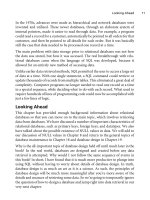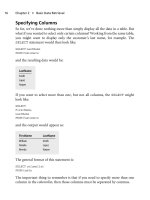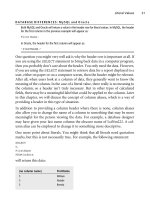The Language of SQL- P6 pptx
Bạn đang xem bản rút gọn của tài liệu. Xem và tải ngay bản đầy đủ của tài liệu tại đây (130.23 KB, 5 trang )
In the 1970s, advances were made as hierarchical and network databases were
invented and utilized. These newer databases, through an elaborate system of
internal pointers, made it easier to read through data. For example, a program
could read a record for a customer, automatically be pointed to all orders for that
customer, and then be pointed to all details for each order. But it was basically
still the case that data needed to be processed one record at a time.
The main problem with data storage prior to relational databases was not how
the data was stored, but how it was accessed. The real breakthrough with rela-
tional databases came when the language of SQL was developed, because it
allowed for an entirely new method of accessing data.
Unlike earlier data retrieval methods, SQL permitted the user to access a large set
of data at a time. With one single statement, a SQL command could retrieve or
update thousands of records from multiple tables. This eliminated a great deal of
complexity. Computer programs no longer needed to read one record at a time
in a special sequence, while deciding what to do with each record. What used to
require hundreds of lines of programming code could now be accomplished with
just a few lines of logic.
Looking Ahead
This chapter has provided enough background information about relational
databases so that you can move on to the main topic, which involves retrieving
data from databases. We have discussed a number of important characteristics of
relational databases, such as primary keys, foreign keys, and datatypes. We also
have talked about the possible existence of NULL values in data. We will add to
our discussion of NULL values in Chapter 8 and return to the general topics of
database maintenance in Chapter 18 and database design in Chapter 19.
Why is the all-important topic of database design held off until much later in the
book? In the real world, databases are designed and created before any data
retrieval is attempted. Why would I not follow the same sequence of events in
this book? In short, I have found that it is much more productive to plunge into
using SQL without having to worry about details of database design. In truth,
database design is as much an art as it is a science. As such, the principles of
database design will be much more meaningful after you’re more aware of the
details and nuances of retrieving some data. So we’re going to temporarily ignore
the question of how to design a database and jump right into data retrieval in our
very next chapter.
Looking Ahead 11
This page intentionally left blank
chapter 2
Basic Data
Retrieval
Keywords Introduced: SELECT, FROM
In this chapter, we are going to begin our exploration of the most important
topic in SQL: how to retrieve data from a database. Whether you’re in a large or
small organization, the most common request made of SQL developers is the
request for a report. Of course, it’s a nontrivial exercise to get data into a data-
base. But once data is in a database, the energies of business analysts turn to the
wealth of data at their disposal and the desire to extract useful information from
all that data. This is where the fun and usefulness of SQL begins.
The emphasis in this book on data retrieval corresponds nicely to the real-world
demands that are placed on SQL de velopers. Your typical analysts don’t care
about how data gets into a database, but they do care about how to get some-
thing out of it. Your knowledge of SQL will go a long way toward helping your
organization unlock the secrets of the dat a stored in their databases.
A Simple SELECT
The ability to retrieve data in SQL is accomplished through something called the
SELECT statement. Without a lot of preliminary explanation, here is an example
of the simplest possible
SELECT statement:
SELECT * FROM Customers
In the SQL language, as in all computer languages, certain words are keywords.
These words have a special meaning and must be used in a particular way. In this
13
statement, the words SELECT and FROM are keywords. The SELECT keyword
indicates that you are beginning a
SELECT statement.
The
FROM keyword is used to designate the table from which data is to be
retrieved. The name of the table follows the
FROM. In this case, the table name is
Customers.
As is the custom, I will print keywords in all capital letters. This is done to ensure
that they are noticeable.
The asterisk (*) in this example is a special symbol that means ‘‘all columns.’’
So to sum up, the statement means: Select all columns from the Customers
table.
If the Customers table looks like this:
CustomerID FirstName LastName
1 William Smith
2 Natalie Lopez
3 Brenda Harper
then this SELECT will return the following data:
CustomerID FirstName LastName
1 William Smith
2 Natalie Lopez
3 Brenda Harper
In other words, it brings back everything in the table.
In the first chapter, I mentioned that it’s a common practice to specify a primary
key for all tables. In the previous example, the CustomerID column is such a
column. I also mentioned that primary keys are sometimes set up to generate
sequential numbers automatically in a numeric sequence as rows are added to a
table. This is the case in the previous example. Most of the sample data I’ll show
throughout this book will show a similar column that is both a primary key and
defined as auto-increment. By convention, this is generally the first column in a
table.
Chapter 2
■
Basic Data Retrieval14
Syntax Notes
Two points must be remembered when writing any SQL statement. First, the
keywords in SQL are not case sensitive. The word
SELECT is treated identically
to ‘‘select’’ or ‘‘Select.’’
Second, a SQL statement can be written on any number of lines. For example, the
SQL statement:
SELECT * FROM Customers
is identical to:
SELECT *
FROM Customers
It’s usually a good idea to begin each important keyword on a separate line.
When we get to more complex SQL statements, this will make it easier to quickly
grasp the meaning of the statement.
Finally, as I present different SQL statements in this book, I will often show both
a specific example and a more general format. For instance, the general format of
the previous statement would be shown as this:
SELECT *
FROM table
Italics are used to indicate a general expression. The italicized word table means
that you can substitute any table name of your own in that spot. So when you see
italicized words in any SQL statement in this book, that is simply my way of
saying that you can put any valid word or phrase in that location.
DATABASE DIFFERENCES: MySQL and Oracle
Many SQL implementations require a semicolon (;) at the end of every statement. This is true of
MySQL and Oracle, but not of Microsoft SQL Server. For simplicity, I will show SQL statements
without semicolons in this book. If you’re using MySQL or Oracle, you’ll need to add a semicolon to
the end of your statements. Therefore, the previous statement would appear as:
SELECT *
FROM Customers;
Syntax Notes 15









